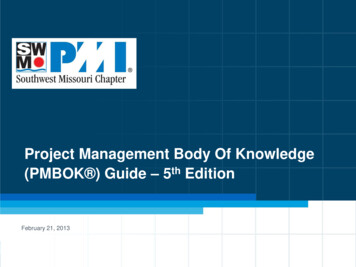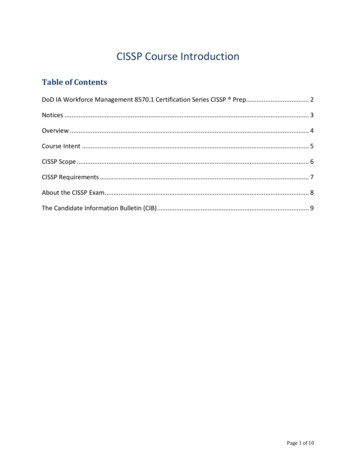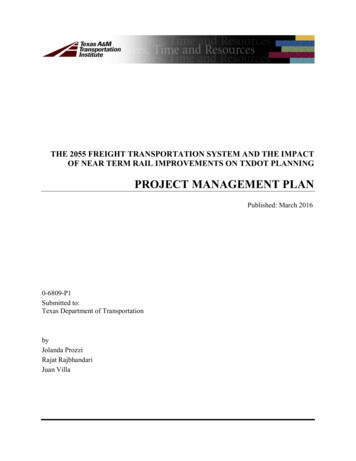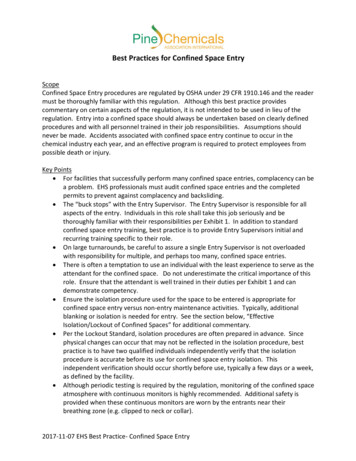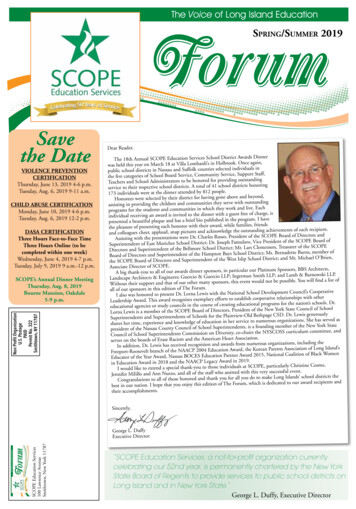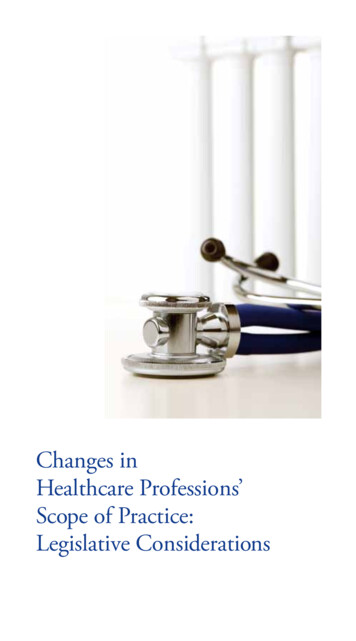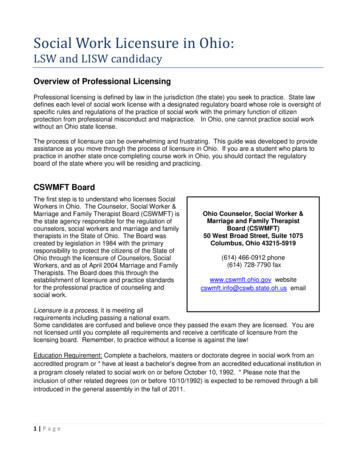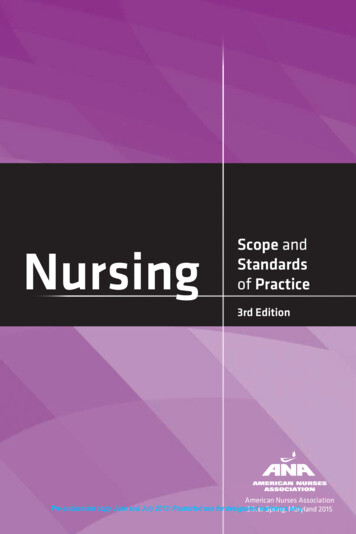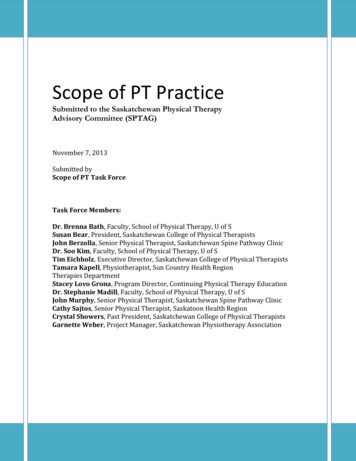
Transcription
Scope of Practice:Are Your Fitness andWellness Staff MembersCrossing Over the Line intoa Licensed Practice?JoAnn M. Eickhoff-Shemek, Ph.D., FACSM, FAWHPProfessor, Exercise ScienceUniversity of South Florida, Tampaeickhoff@usf.edu
Overview of Topics Legal Context – Criminal and Civil Law Types of credentialing– Accreditation, Certification, State Licensure Scope of practice – defined by:– State Licensure Laws Examples– Professional organizations Examples Case Law Examples– Criminal law – violation of state statute– Civil law -- negligence Professional Standard of Care -- Defined Risk Management Strategies The Licensure Debate
The Legal Context: Criminal Law Criminal Law (1)– Violation of a state or federal statute– Criminal charges are brought against thedefendant (individual who violated thestatute) by the government (e.g., districtattorney)– Proof needed: Beyond a reasonable doubt(100%)– If found “guilty” – penalties can include: Fine, community service, probation, imprisonment,or any combination of these
The Legal Context: Civil Law Civil Law, e.g., Tort law and Contract law (1)– Tort law – applicable to scope of practice An infringement (a civil wrong) by one person of the legallyrecognized rights of another Three levels of fault– Intentional, Negligence, and Strict Liability» Focus: Negligence and its application to scope ofpractice– Plaintiff (injured party) filing the negligenceclaim/lawsuit against the defendant (e.g., fitness professionaland/or facility) has the burden of proof (preponderance of theevidence or over 50%) and must prove the defendant had: A dutyBreached that dutyThe breach “caused” the injuryDamages– If found “liable” by a judge or jury, the defendant willhave to pay out “monetary” damages to the plaintiff
Types of CredentialingAccreditationCertificationState Licensure Organizations andprograms Self-regulated Voluntary Individuals Self-regulated Voluntary Individuals Government-regulated Required Examples: ACSM HFS and CPT,NSCA CSCS and CPT Numerous others inthe fitness field MFA – Medical FitnessFacility Certification Examples – HealthProfessions Dietetics Athletic training Physical therapy Medicine Nursing Examples: NCCA accreditation ofcertification exams CAAHEP (academicexercise scienceprograms)The fitness profession is self-regulated through certification and accreditationprograms. Q: Should it be government-regulated through licensure?
Scope of Practice Violations Occur Two Ways (2) Crossing over the line into a licensed practice,e.g., dietetics, physical therapy– Conducting a practice that is defined by state licensurestatutes, but the fitness trainer does not possess thelicense Scope of practice is specifically defined in these statutes Negligent conduct– Practicing beyond one’s credentials (e.g., education,certification) Training a client with a known medical condition but thefitness trainer does not possess the necessary credentialsregarding the medical condition and what precautions need tobe taken to help prevent harm to that client Scope of practice often defined in certifications offered byprofessional organizations– Incompetence Fitness trainer may have the necessary credentials but doesnot apply a safe and effective program, given the individual’shealth/fitness history
Scope of Practice:Defined by State Licensing LawsDefine the scope of practice within the statuteExample: Florida Dietetics and Nutrition Practice Act 468.5031. “Licensure” with Exclusive Scope of Practice2. Scope of Practice:468.503 “Dietetics and nutrition practice” shall include assessingnutrition needs and status using appropriate data; recommendingappropriate dietary regimens, nutrition support, and nutrient intake;improving health status through nutrition research, counseling, andeducation;8)“Nutrition assessment” means the evaluation of the nutritionneeds of individuals or groups, using appropriate data to determinenutrient needs or status and make appropriate nutritionrecommendations.(9)“Nutrition counseling” means advising and assisting individualsor groups on appropriate nutrition intake by integrating informationfrom the nutrition assessment.
Scope of Practice:State Licensing Laws -- Cont.Define the scope of practice within the statuteExample: Ohio “Unauthorized Practice of Dietetics”Statute*Practice of Dietetics for Licensed Dietitians:(1) Nutritional assessment to determine nutritional needsand to recommend appropriate nutritional intake,including enteral and parenteral nutrition;(2) Nutritional counseling or education as components orpreventative, curative, and restorative health care;(3) Development, administration, evaluation, consultationregarding nutritional care standards.*Dietetics. Ohio Rev. Code Ann.§4759.01(A)
Ohio Unauthorized Practice of Dietetics Statute- Cont.General nonmedical nutrition informationfor non-licensed dieticians principles of good nutrition and food preparation;foods to be included in the normal daily diet;the essential nutrients needed by the body;recommended amounts of the essential nutrients;the actions of nutrients on the body;the effects of deficiencies or excesses of nutrients;orfood and supplements that are good sources ofessential nutrients
Penalties for Violating State Licensing Statutesare Specified in the Statute*A Cease and Desist Notice:Issued to any person violating this statute. The violationcan result in a fine between 500 and 5000. Each daythe unlicensed practice continues after the notice, aseparate violation can be charged.3rd Degree Felony: Minimum penalty -- Fine of 1000 andmandatory period of incarceration of 1 year.2nd Degree Felony: Practice results in serious bodily injury;Minimum penalty same as 3rd degree felony.1st degree Misdemeanor: Minimum penaltyis a fine of 500 and imprisonment for 30 days.*From Florida’s Law: Unlicensed practice of a health care profession.Fla Stat. § 456.065
States Requiring Licensure:Practice of DieteticsForty-six states (plus one pending) have enacted legislationregulating the practice of dietetics either through state licensure orstatutory certification State licensure, e.g., need to have the R.D. credential topractice (35 states plus Michigan,pending) – no one else canpractice Statutory certification – limits the use of particular titles (e.g.,certified dietitian, certified nutritionist) to individuals meeting thestate’s credentialing requirements; non-certified individuals canpractice but cannot use certain titles (11 states) No statute – 3 states (Arizona, Colorado, New Jersey)For specific requirements in each state, go to:http://www.cdrnet.org/state-licensure (Commission on Dietetic Registration –credentialing agency of the Academy of Nutrition and Dietetics)
Registered Dietitians (RD) have: Completed the minimum of a Baccalaureate degreegranted by a U.S. regionally accredited college or university,or foreign equivalent; Met current minimum academic requirements (didacticprogram in dietetics) as approved by the AccreditationCouncil for Education in Nutrition and Dietetics (ACEND) ofthe Academy of Nutrition and Dietetics; Completed a supervised practice program accredited bythe Accreditation Council for Education in Nutrition andDietetics (ACEND) of the Academy of Nutrition and Dietetics; Successfully completed the Registration Examination forDietitiansTaken From: etitian-rd
Clinical Exercise Physiologist:Licensure in Louisiana (since January 1, 1996)Definition in the statute:“Clinical exercise physiologist” means a person who, under the direction,approval, and supervision of a licensed physician, formulates, develops,and implements exercise protocols and programs, administers gradedexercise tests, and provides education regarding such exerciseprograms and tests in a cardio pulmonary rehabilitation program toindividuals with deficiencies of the cardiovascular system, diabetes, lipiddisorders, hypertension, cancer, chronic obstructive pulmonary disease,arthritis, renal disease, organ transplant, peripheral vascular disease,and obesity.LSA-R.S. 37:3422
Clinical Exercise Physiologist:Licensure in Louisiana (since January 1, 1996)Qualifications Include: Has a master of science degree or a master of education degree inan exercise studies curriculum from an accredited school and hassuccessfully completed an internship of three hundred hours inexercise physiology under the supervision of a licensed exercisephysiologist.Has passed an examination to the satisfaction of the board asprovided in R.S. 37:3427 -- the examination shall test the applicant'sknowledge of such subjects as the board may consider useful indetermining the applicant's fitness to practice clinical exercisephysiology but may not go beyond the scope of the examination forclinical exercise physiologists as described by the American Collegeof Sports Medicine.LSA-R.S. 37:3425
Scope of Practice:Defined by Professional OrganizationsDefine the scope of practice within theircertifications: ACSM:CPT – Certified Personal TrainerHFS – Health Fitness SpecialistCES – Clinical Exercise SpecialistRCEP – Registered Clinical Exercise Physiologist NSCA:CPT – Certified Personal TrainerCSCS – Certified Strength & Conditioning Specialist(work with athletes in a team setting)CSPS – Certified Special Population Specialist
Scope of Practice:Professional OrganizationsACSM CPTCertified Personal Trainer The ACSM Certified Personal Trainer (CPT) is qualified to plan and implementexercise programs for healthy individuals or those who have medicalclearance to exercise. The CPT facilitates motivation and adherence as wellas develops and administers programs designed to enhance muscularstrength, endurance, flexibility, cardiorespiratory fitness, body composition,and/or any of the motor skill related components of physical fitness - i.e.,balance, coordination and reaction time, to name a few.Qualifications 18 years old High school diploma or equivalent Adult CPR/AED CertificationTaken from: nal-trainer
Scope of Practice:Professional OrganizationsACSM HFSCertified Health Fitness SpecialistSMACSM Certified Health Fitness Specialists (HFS) take personal training to anadvanced level by working with individuals with medically controlled diseases.The HFS masters the necessary skills to perform pre-exercise health riskassessments and conduct physical fitness assessments, among other healthtasks, to support clients in adopting and maintaining healthy lifestyle behaviors.Qualifications Minimum of a Bachelor's Degree in Exercise Science, ExercisePhysiology or Kinesiology (the degree must cover certain course work) Adult CPR/AED Certification (with hands-on practical skills component)Taken From: h-fitness-specialist.
ACSM HFS -- Certified Health Fitness SpecialistSMACSM is proposing a name change of this certification to:Certified Exercise Physiologist (EP-C)Rationale for the Change: To establish a “protected” title to improve recognition of “degreed” exerciseprofessionalsConsistent with the U.S. Bureau of Labor Statistics (29-1128) definition ofexercise physiologist:“one who addresses, plans, or implements fitness programs that include exercise orphysical activities such as those designed to improve cardiorespiratory function, bodycomposition, muscle strength, muscular endurance, or flexibility (excludes physicaltherapist, athletic trainers, fitness trainers and aerobics instructors). HFS is ambiguous––Does not express to those outside of ACSM that individuals with the HFS certificationare “degreed” professionalsDoes not adequately indicate to consumers the educational background of the HFScertified individualSource: E-mail sent to ACSM certified individuals to solicit comment about thisname change (September, 2014).
Scope of Practice:Professional OrganizationsACSM CESThe ACSM Certified Clinical Exercise Specialist (CES) conducts preparticipation health screening, maximal and submaximal graded exercise tests,and performs strength, flexibility and body composition tests for patients andclients challenged with cardiovascular, pulmonary, and metabolic diseases anddisorders, as well as with apparently healthy populations.Qualifications Bachelor's Degree in Exercise Science, Exercise Physiology or Kinesiology(the degree must cover certain course work) Practical Experience in a clinical exercise program (certain types ofexperience is required)–– Minimum of 400 Hours if a graduate of a CAAHEP Accredited program (through the CoAES)Minimum of 500 Hours if a graduate of a non-CAAHEP Accredited program (through theCoAES)Basic Life Support Provider or CPR for the Professional Rescuercertification (with hands-on practical skills component)Taken From: cal-exercise-specialist
Scope of Practice:Professional OrganizationsACSM RCEPACSM's Registered Clinical Exercise Physiologists (RCEP) are certifiedhealth professionals that utilize scientific rationale to design, implement andsupervise exercise programming for those with chronic diseases, conditionsand/or physical shortcomings. Services provided by an RCEP include, but arenot limited to, individuals with cardiovascular, pulmonary, metabolic, orthopedic,musculoskeletal, neuromuscular, neoplastic, immunologic, and hematologicdisease.Qualifications Minimum of Master's degree in Exercise Science, Exercise Physiology, orKinesiology - at least two graduate level courses must cover exercise physiology, andclinical exercise testing, exercise prescription, exercise training and clinical assessment(NOTE: 100% online Master's degree programs are not accepted).600 Hours of preceptor-supervised clinical experience.Basic Life Support Provider or CPR for the Professional Rescuer certification(with hands-on practical skills component)Taken From: ical-exercise-physiologist.
Scope of Practice:Professional OrganizationsNSCA CPT NSCA-Certified Personal Trainers (NSCA-CPT) are health/fitnessprofessionals who, using an individualized approach, assess, motivate,educate and train clients regarding their health and fitness needs.Certified personal trainers design safe and effective exercise programs,provide the guidance to help clients achieve their personal health/fitnessgoals and respond appropriately in emergency situations.Recognizing their own area of expertise, personal trainers refer clients toother health care professionals when appropriate. Qualifications 18 years old High school diploma or equivalent Adult CPR/AED Certification (with hands-on practical skills component)Personal trainers with specialized expertise may also be involved in training clients withorthopedic, cardiovascular and other chronic conditions. Although no formal post-secondarycourse work is required, candidates are expected to have a good knowledge of biomechanicalconcepts, training adaptations, anatomy, exercise physiology, program design guidelines andcurrent position papers pertaining to special populations.Taken From: http://www.nsca.com/NSCA-CPT Certification 2
Scope of Practice:Professional OrganizationsNSCA CSPS Certified Special Population Specialist (CSPSs) are fitness professionals who, usingan individualized approach, assess, motivate, educate, and train special populationclients of all ages regarding their health and fitness needs, preventively, and incollaboration with healthcare professionals. Special populations include those withchronic and temporary health conditions. CSPSs design safe and effective exercise programs, provide the guidance to helpclients achieve their personal health/fitness goals, and recognize and respond toemergency situations. Recognizing their own areas of expertise, CSPSs receivereferrals from and refer clients to other healthcare providers as appropriate. Qualifications Possess either NSCA CPT or CSCS certification Current CPR Certification for Healthcare Provider, Professional Rescuer, orHigher Bachelor's Degree in Exercise Science or Related Field (e.g., physical therapy,chiropractic medicine) Minimum of 250 hours of related practical experienceTaken from: http://www.nsca.com/Certification/CSPS
CASE LAW Examples – Criminal Law(Violation of state licensing statutes)1) Stetina v. State Medical Licensing Board (3)2) Ohio Board of Dietetics v. Brown (4)3) Lipski v. North Carolina Board of Dietetics/Nutrition (5)
Stetina v. State Medical Licensing BoardDefendant in this case was assessing (using questionnairesand examining eyes) and making determinations such asnutritional problems and abdominal problems andrecommending specific remedies, e.g., colonic irrigation,mineral water, kelp, more raw food, etc.The appellate court upheld the trial court’s ruling:“1. The Defendant, Janice R. Stetina, is herebypermanently enjoined from practicing medicine inIndiana until she is issued a license by the state ofIndiana.
Stetina v. State Medical Licensing Board – Cont.The Defendant, Janice R. Stetina, is not enjoined fromlecturing or educating members of the public on herview of the value of nutrition or from selling products tomembers of the public so long as the defendant doesnotexamine the member, diagnose or treatthe member, sell the member healthproducts based on the Defendant’sassessment of the members’ needs orproblems or otherwise engage in thepractice of medicine ” (pp. 1235-1236).
Stetina v. State Medical Licensing Board – Cont.Defendant claimed that she was not practicing medicinebecause none of the vitamins she recommended requiredmedical prescription and that they can be purchased overthe counter.Quoting a 1978 case, Norville v. Mississippi State MedicalAssociation (364 So.2d 1084), the court stated:“We are fully cognizant that any layman can obtainsuch vitamins and that any retailer can sell vitamins.Purchase of or sale of vitamins is not however the vicewhich is condemned here. Rather the vice condemnedand that which constitutes the unlicensed practice ofmedicine is prescription of vitamins to cure an ailmentor disease for compensation.”
Ohio Board of Dietetics v. BrownDefendant in this case: Performed nutritional assessments andrecommended nutritional supplements to individuals Engaged in nutritional counseling and education forthe purpose of treating specific complaints andailments of individuals Represented himself as a nutritionistThe appellate court upheld the trial court’s rulingallowing the Board’s (Ohio Board of Dietetics) requestfor an injunction (similar to “cease and desist” notice)against the defendantReason: The defendant was not licensed to practicedietetics in the state of Ohio and was engaged in thepractice of dietetics as defined by R.C. 4759.01
Ohio Board of Dietetics v. Brown – Cont.Defendant in this case attempted to excuse his unlawfulactivities by calling himself a “nutritionist” vs. a dietician, but thecourt stated:“the acts defendant performs are more important thanhis title and since he does not possess a license toprovide nutritional counseling and assessments,defendants acts are in violation of R.C. 4759.02”NOTE: A title that someone gives himselfor herself will probably not be a factor indetermining a violation of a state statute(unless titles are clearly defined by statute)– it will be the “conduct” of the individual
Lipski v. North Carolina Board of Dietetics/NutritionDefendant in this case: Liz LipskiNorth Carolina Board of Dietetics/Nutrition informed her that could not practicenutrition in NC The Board asked her to return to college and take several semesters worth ofundergraduate courses common for those studying to be Registered Dietitians, butwhich were not on her program of study as a nutritionist.Her qualifications included: PhD in Clinical Nutrition from the Union Institute MS in Nutrition from Donsbach University Board certified in Clinical Nutrition (CCN) Board certified in Holistic Nutrition (CHN) Director of Doctoral Studies & Educational Director (in nutrition) at HawthornUniversityRather than return to the undergraduate level as a Ph.D., she sold her home,uprooted herself and her family and took her practice to Virginia (one of 11 statesthat has statutory certification protecting titles, i.e., non-RDs can practice but cannotuse certain titles).Read about her appeal at: http://lizappeal.com
CASE LAW Examples – Civil Law(Negligence)Capati v. Crunch Fitness International, et al. (6)Rostai v. Neste Enterprises (7)Proffitt v. Global Fitness Holdings, LLC, et al. (8)Makris v. Scandinavian Health Spa, Inc. (9).
Capati v. Crunch Fitness International, et al. Personal trainer recommended his client Anne Marie Capati (a37 year old woman) take a variety of over the counternutritional and dietary supplements including some thatcontained ephedra The client was also taking prescribed medications forhypertension While exercising at the Club, she became ill, lossconsciousness and later died at the hospital of a brainhemorrhage (stroke) The decedent’s family sought 320 million in damagesclaiming the trainer:– (1) did not advise Capati of the possible negative healthconsequences of certain supplements while on hypertensionmedication– (2) did not possess qualifications necessary for personal training. .SETTLED -- for over 4 million. The defendants (the trainer andCrunch Fitness) were liable for 1.75 million and otherdefendants were liable for the remaining amount, e.g., VitaminShoppe Industries, Inc. was liable for 2 million.
Capati v. Crunch Fitness International, et al. –Cont. Was this conduct within the scope of practice of thispersonal trainer? The personal trainer testified that he had given his clientsuggestions and advice as to certain foods and supplements andthat he did not advise Mrs. Capati that there may be negativehealth consequences for her to do so while on hypertensionmedication and while working outThe personal trainer also testified that he had––––completed high school through a GEDapplied for a correspondence school course to obtain certification inpersonal trainingnot received certification while employed at Crunch Fitnessbeen hired by Crunch Fitness as Level I personal trainer and laterbecame a Level II personal trainer Respondeat superior (legal principle that applied in thiscase) -- employers can be liable for the negligent acts oftheir employees.
Rostai v. Neste Enterprises During his first personal training session, the plaintiff (Rostai, whowas 46 years old, overweight, and inactive) suffered a heart attacktoward the end of his 60-minute session.Continually throughout the workout, the trainer kept pushing Rostaito perform strenuous exercises (repeated sets and fast reps ofbench presses and calisthenics with no rest periods) despite signsand symptoms of overexertion and several requests by Rostai for abreak.By the end of the session, Rostai was in extreme pain and told histrainer to call 911 because he thought he was having a heart attack.Rostai claimed that the defendants (the trainer and facility) werenegligent because the trainer–failed to assess his health and physical condition, in particular, hiscardiac risk factors prior to exercise– aggressively challenged him to perform beyond his level of physicalability and fitness even after observing him exhibiting certainsigns/symptoms,– denied his several requests for a break throughout the session.
Proffitt v. Global Fitness Holdings, LLC, et al. The personal fitness trainer, in the first session with the plaintiff(Proffitt, who had not worked out in 20 years and was overweight),had him perform numerous bouts of strenuous squatting exercisesand directed him to continue the exercises even after signs andsymptoms of overexertion and requests by Proffitt to stop.For many hours after the session, Proffitt experienced extreme painand fatigue and after 38 hours he noticed his urine was dark brown.He went to the emergency room where he was diagnosed withrhabdomyolysis (resulting in permanent injuries including 30% lossof muscle tissue in both quadriceps muscles) and hospitalized for 8days.Proffitt claimed that the defendants were negligent because thetrainer failed to:–––assess the health/fitness status of the clientprovide an exercise program within client’s safe fitness capacityrespond to client’s complaints of fatigue during the training session.And the facility failed to ensure that the fitness trainer was properlytrained to assess plaintiff’s health history, assess his fitnessabilities, and design an appropriate training program.
Scope of Practice Issues in Rostai and Proffitt The lack of competence of the fitness trainers wasevident in both casesIt appears neither of the trainers knew how to properly design anexercise program for these clients (or any clients for that matter)They did not: conduct pre-activity health screening to determine if medicalclearance was needed perform a fitness assessment to ascertain initial fitness levelsand abilities understand how to design and implement a proper workout fordeconditioned, novice exercisers such as knowing how toproperly apply a basic safety principle of exercise calledprogression realize that signs and symptoms of overexertion can lead toserious consequences such as rhabdo or a heart attack,especially if strenuous exercise continues, and grant the repeated requests for a break made by their clientsduring the workout and instead, pushed them more and moreabove their limits.
Court Rulings in Rostai and Proffitt Rostai– The court ruled that the Rostai “assumed the risks” even though thecourt acknowledged that the trainer was negligent, i.e., did not accessplaintiff’s level of fitness and may have interpreted plaintiff’s complaints(tiredness, shortness of breath, profuse sweating) as usual signs ofphysical exertion vs. signs/symptoms of a heart attack. The courtexplained their ruling by stating that there was no evidence ofintentional or reckless conduct on part of the trainer, and therefore theplaintiff assumed the risks.– Note: The primary assumption of risk defense is usually effective inprotecting defendants for injuries due to inherent risks but not fornegligent conduct. Legal scholars have disagreed with this court’s rulingand reasoning. Proffitt– SETTLED – for 75,000 that included medical expenses of 20,000and lost wages of 6,000.– Note: Other similar lawsuits involving rhabdo against fitness trainersand facilities also have occurred. For example, In Mimms v. RuthlessTraining Concepts, LLC (10), the plaintiff was awarded 300,000 indamages.
Makris v. Scandinavian Health Spa, Inc. While using the leg press during her first personal training session,the plaintiff (Makris) informed her trainer that she felt a sharp pain inher neck that radiated down her arm – the trainer told her the pain wasdue to upper body weakness.Makris experiences the same pain during subsequent trainingsessions when using the leg press and believes the trainer who toldher that the pain would subside as she became stronger. (Pain wasactually due to 3 herniated cervical disks)Makris filed a personal injury lawsuit against the defendants allegingthey “rendered negligent training, monitoring, instruction,supervision, and advice”It appears that the personal fitness trainer in Makris did not possessthe necessary knowledge, skills, and abilities for training clients She was not able to distinguish different types of pain, i.e., general pain ordiscomfort associated with training versus pain associated with a possibleinjury or medical problemShe perhaps “diagnosed” the pain – stating to the plaintiff it was due toupper body weakness and “treated” it by having her perform the exercise
The Professional Standard of Care -- DefinedBetty van der Smissen states “if one acceptsresponsibility for giving leadership to an activity orproviding a service, one’s performance is measuredagainst the standard of care of a qualified professional forthat situation (10, p. 40). “For that situation” is determined by reference to thefollowing three factors:– The nature of the activity– The type of participants– The environmental conditions.
The Professional Standard of Care -- DefinedNature of the activity: The professional must be aware of the skills and abilitiesthe participant needs to participate “safely” in the activity,e.g., if these are complex or advanced, the professionalmust have the knowledge to apply these skills and abilities.– The exercise programs in Rostai and Proffitt would be considered“advanced” programs (high-intensity programs) and it appeared thatthe fitness trainers did not have the necessary knowledge/skills tosafely design a simple, beginning level exercise program, let alone anadvanced program.
The Professional Standard of Care -- DefinedTypes of participants: The professional must be aware of individual factors of theparticipant, e.g., health conditions that impose increasedrisks and know how to minimize those risks.– Fitness professionals that train individuals with medical conditionsneed to possess advanced certification and education in the exercisesciences such as a certification and academic course work in clinicalexercise.– Fitness trainers, like the one in Rostai, who do not have theseadvanced qualifications (and competencies) but train individuals whoare “at risk” or have medical conditions anyway, will likely not be ableto meet the professional standard of care.
The Professional Standard of Care -- DefinedEnvironmental conditions: The professional must be aware of any conditions that mayincrease risks, e.g., heat, humidity, slippery floor surfaces,and know how to minimize those risks.– The professional needs to be aware of, understand, and be able toapply the latest scientific information, e.g., the
Scope of Practice Violations Occur Two Ways (2) Crossing over the line into a licensed practice, e.g., dietetics, physical therapy -Conducting a practice that is defined by state licensure statutes, but the fitness trainer does not possess the license Scope of practice is specifically defined in these statutes Negligent conduct .
